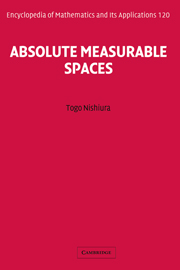Book contents
- Frontmatter
- Contents
- Preface
- Acknowledgements
- 1 The absolute property
- 2 The universally measurable property
- 3 The homeomorphism group of X
- 4 Real-valued functions
- 5 Hausdorff measure and dimension
- 6 Martin axiom
- Appendix A Preliminary material
- Appendix B Probability theoretic approach
- Appendix C Cantor spaces
- Appendix D Dimensions and measures
- Bibliography
- Notation index
- Author index
- Subject index
2 - The universally measurable property
Published online by Cambridge University Press: 14 May 2010
- Frontmatter
- Contents
- Preface
- Acknowledgements
- 1 The absolute property
- 2 The universally measurable property
- 3 The homeomorphism group of X
- 4 Real-valued functions
- 5 Hausdorff measure and dimension
- 6 Martin axiom
- Appendix A Preliminary material
- Appendix B Probability theoretic approach
- Appendix C Cantor spaces
- Appendix D Dimensions and measures
- Bibliography
- Notation index
- Author index
- Subject index
Summary
The property of this chapter historically precedes that of absolute measurable spaces. The works of Sierpiński and Szpilrajn [142] and Szpilrajn–Marczewski [152] make more natural the introduction of absolute measurable spaces before the development of universally measurable sets in a space. The universally measurable property concerns sets in a fixed separable metrizable space rather than the property of topological embedding of a space into other spaces. This change of emphasis will be highlighted by switching the modifier “absolute” to “universally.” Interesting situations arise when the fixed space is absolute measurable.
The notion of a universally measurable set in a space is more complicated than that of absolute measurable spaces. Emphasis will be placed on the interplay between universally measurable sets in a space and absolute measurable subspaces. Of particular importance is the coinciding of universally null sets in a space X and the absolute null subspaces of X. Included is a presentation of a sharpening, due to Darst and Grzegorek, of the Purves theorem.
A closure–like operation, called the universally positive closure, is introduced to facilitate the study of the topological support of measures on X. This closure operation is used to define positive measures, those whose topological supports are as large as possible. It is shown that the notion of universally measurable sets in X can be achieved by using only those measures that are positive.
The Grzegorek and Ryll–Nardzewski solution to the natural question of symmetric differences of Borel sets and universally null sets is given.
- Type
- Chapter
- Information
- Absolute Measurable Spaces , pp. 30 - 52Publisher: Cambridge University PressPrint publication year: 2008

